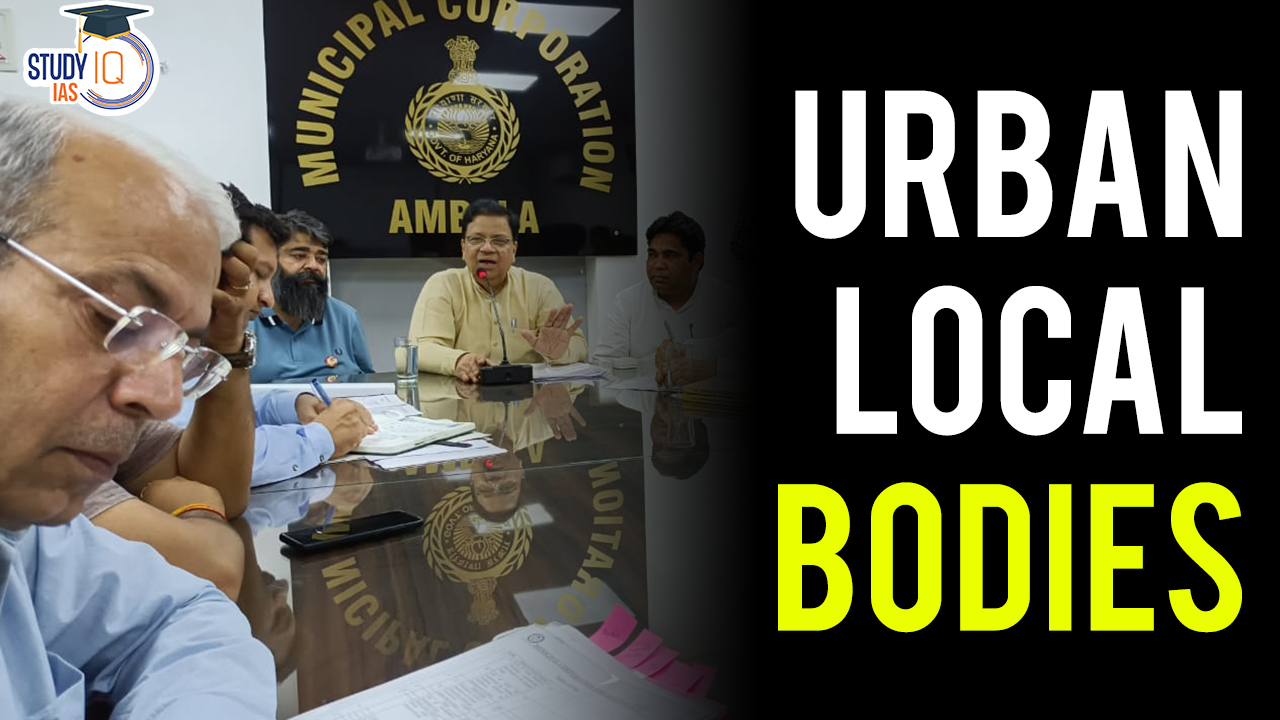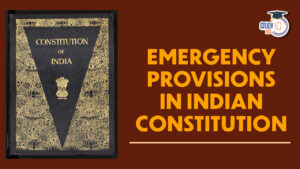Table of Contents
Urban Local Bodies (ULBs) play a vital role in the governance and administration of urban areas in India. They are local self-government institutions responsible for managing urban centers, including cities and towns. ULBs are empowered by state governments to handle a wide range of responsibilities that directly affect the urban populace, including urban planning, development, waste management, and public health.
The importance of Urban Local Bodies is underscored in the UPSC syllabus under Indian Polity, making it an essential topic for aspirants preparing for the civil services examination. Understanding their historical context, structure, functions, challenges, and the need for reforms is key to tackling questions in both Prelims and Mains. Here is an updated and detailed breakdown of ULBs.
History of Urban Local Bodies
- 1687: The concept of urban local governance in India can be traced back to the colonial era. The first municipal corporation was established in Madras (Chennai) in 1687 by the British East India Company. This was followed by the establishment of municipal corporations in Bombay (Mumbai) and Calcutta (Kolkata) in 1726.
- 1870: A landmark in the history of local self-government came with Lord Mayo’s resolution for financial decentralization, which allowed greater participation of local bodies in managing finances.
- 1882: The next significant milestone was the Lord Ripon’s Resolution of 1882, often referred to as the “Magna Carta of Local Self-Government.” This resolution emphasized elected representatives’ involvement and expanded the scope of local governments.
- 1919: The Government of India Act, 1919 further advanced local governance by transferring powers to local self-government institutions.
- 1935: The Government of India Act, 1935 made local self-government a provincial subject, introducing a system of provincial autonomy and thus empowering provincial legislatures to make laws regarding local bodies.
- 1992: The most transformative step in local governance came with the Constitution (74th Amendment) Act, 1992, which provided constitutional status to Urban Local Bodies and introduced three-tier governance across urban areas.
Structure of Urban Local Bodies
There are various types of urban local bodies in India, catering to different sizes of urban areas:
1. Municipal Corporations
- Established in large urban areas with populations generally exceeding one million.
- Composition: Divided into three branches—Council, Standing Committees, and Municipal Commissioner.
- Council: Composed of elected representatives (Councillors) led by a Mayor. The council functions as the legislative wing and is responsible for policy-making.
- Standing Committees: Handle specific functions such as health, education, and finance.
- Municipal Commissioner: Appointed by the state government and acts as the executive head, implementing decisions made by the council.
2. Municipalities
- Established in smaller urban areas or towns**.**
- Composition: Similar to municipal corporations with elected council members, standing committees, and a Chief Executive Officer (CEO).
- Chairperson: Heads the council and is supported by a Vice-Chairperson. The CEO, appointed by the state government, oversees day-to-day administration.
3. Notified Area Committees
- Purpose: Established for areas undergoing rapid urbanization but not yet qualifying as municipalities.
- Composition: All members are appointed by the state government, and there are no elections.
4. Town Area Committees
- Function: Govern small towns and manage essential services such as street lighting, sanitation, and drainage.
- Composition: Can be either fully elected, fully nominated, or a mix of both.
5. Cantonment Boards
- Purpose: Manage municipal functions in cantonment areas where military populations are predominant.
- Established: Under the Cantonments Act, 2006 and administered by the Ministry of Defence.
- Categories: Classified into four categories based on the civilian population in the area.
6. Townships
- Purpose: Typically established by large public enterprises to provide civic services to employees in housing colonies.
- Composition: Managed by appointed officials rather than elected representatives.
7. Port Trusts
- Established: In cities with significant port activity, such as Mumbai, Kolkata, and Chennai.
- Function: Manage port operations, security, and public amenities.
- Composition: Include both elected and nominated members, headed by a Chairperson.
8. Special Purpose Agencies
- Function: Handle specific urban functions such as water supply, transport, or pollution control.
- Composition: Function-specific rather than area-specific and are either statutory bodies or departments.
Constitutional Provisions for Urban Local Bodies
The 74th Constitutional Amendment Act of 1992 established the framework for decentralized urban governance. Key constitutional provisions include:
- Article 243Q: Mandates the constitution of Nagar Panchayats, Municipal Councils, and Municipal Corporations based on the size and population of urban areas.
- Article 243R: Provides for the composition of municipalities, with members elected from constituencies called wards.
- Article 243S: Establishes Ward Committees for municipalities with a population above a certain threshold.
- Article 243T: Reserves seats for Scheduled Castes, Scheduled Tribes, and women in every municipality.
- Article 243W: Specifies the powers, authority, and responsibilities of municipalities, including urban planning and regulation of land use.
- Article 243X: Empowers state legislatures to authorize municipalities to levy taxes, duties, tolls, and fees.
Objectives and Functions of Urban Local Bodies
ULBs are tasked with delivering a wide range of public services effectively and efficiently. Their primary responsibilities include:
- Urban Planning: Preparation of urban development plans and zoning regulations.
- Public Services: Ensuring proper water supply, sanitation, waste management, public health services, and infrastructure development.
- Social and Economic Development: Formulating and implementing strategies for the socio-economic growth of urban areas.
- Regulation of Land Use: Controlling land development and construction activities within municipal boundaries.
- Implementation of Central Government Policies: Acting as grassroots-level implementing bodies for schemes such as Swachh Bharat Abhiyan, AMRUT, and Smart Cities Mission.
- Poverty Alleviation: Initiating and managing programs aimed at eradicating urban poverty.
Challenges Faced by Urban Local Bodies
Despite their significance, Urban Local Bodies face several challenges:
- Lack of Financial Resources: ULBs often lack sufficient funds to carry out their responsibilities. Many smaller municipalities struggle to even pay salaries on time.
- Limited Administrative Capacity: There is often a shortage of skilled manpower and outdated technology in ULBs, leading to inefficiency.
- Corruption: Inadequate compensation and lack of oversight contribute to corrupt practices in some urban bodies, resulting in revenue loss.
- Political Interference: Urban bodies are frequently used as platforms for political gain, leading to the prioritization of personal agendas over public welfare.
- Weak Accountability Mechanisms: Many urban services are handled by parastatal agencies, which are not accountable to local governments, leading to poor coordination and service delivery.
Reforms in Urban Local Bodies
In response to these challenges, several states have initiated ULB reforms aimed at increasing financial autonomy, improving service delivery, and enhancing the efficiency of urban governance. Some reforms include:
- Financial Reforms: States like Telangana, Andhra Pradesh, Madhya Pradesh, and Rajasthan have completed ULB reforms to enhance revenue generation and resource management.
- Governance Reforms: Emphasis on decentralization and greater citizen participation in urban governance through initiatives like the Smart Cities Mission and Atal Mission for Rejuvenation and Urban Transformation (AMRUT).
Conclusion
Urban Local Bodies are essential components of India’s urban governance system, playing a crucial role in managing the complexities of growing urban areas. UPSC aspirants must have a thorough understanding of ULBs, their historical evolution, constitutional provisions, functions, challenges, and reforms, as these are frequently covered in exams. Effective urban governance is key to sustainable development and improving the quality of life in Indian cities, making ULBs a critical topic for future policymakers.


 Indian Secularism: Constitutional Provis...
Indian Secularism: Constitutional Provis...
 India Mediation Campaign, Objectives, Pr...
India Mediation Campaign, Objectives, Pr...
 Emergency Provisions in Indian Constitut...
Emergency Provisions in Indian Constitut...





















